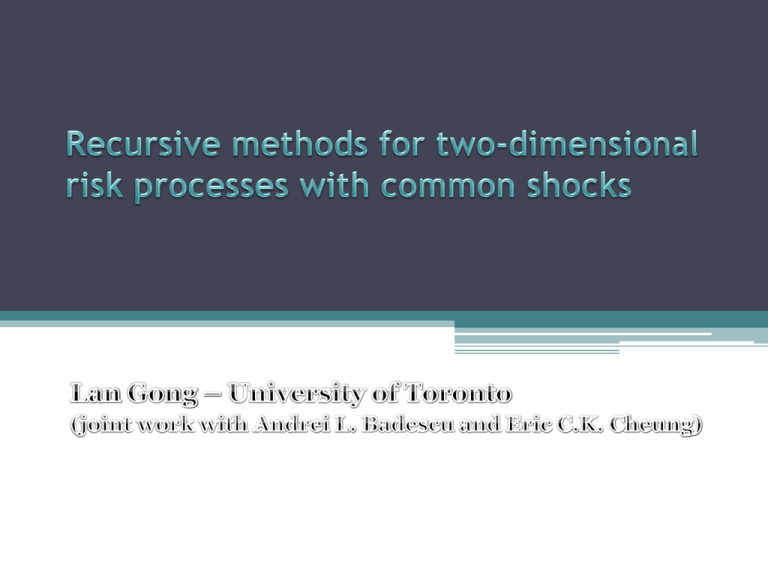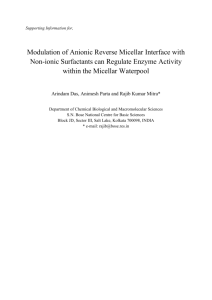Lan Gong
advertisement

•
•
•
•
•
Introduction
A recursive approach
A Gerber Shiu function at claim instants
Numerical illustrations
Conclusions
• Chan et al. (2003) , Dang et al. (2009)
U i (t ) ui ci t
Ni (t )
i
X
k,
t 0; i 1,2
(1)
k 1
• u i - the initial capital of the i-th class of business;
• ci - the premium rate of the i-th class of business;
i
• X k - the k-th claim amount in the i-th risk process, with common cdf Fi () and
pdf f i () ;
• N i (t ) - the counting process for the i-th risk process.
N1 (t ) and N 2(t ) are common shock correlated Poisson processes
occurring at rates 1 and 2 respectively.
N1 (t ) N11 (t ) N12 (t )
N2 (t ) N22 (t ) N12 (t )
where N11 (t ), N22 (t ) and N12 (t ) are independent Poisson processes with
rates 11 , 22 and 12 ;
•
Tor inf{t 0 | min{U1 (t ),U 2 (t )} 0} min(1, 2 )
•
Tsim inf{t 0 | max{U1 (t ),U 2 (t )} 0}
•
Tand max(1 , 2 )
•
Tsum inf{t 0 | U1 (t ) U 2 (t ) 0}
• Chan et al. (2003)
• Cai and Li (2005)
• Yuen et al. (2006)
• Li et al. (2007)
• Dang et al. (2009)
Chan et al. (2003) for 11 22 0
•
c1
•
u1 u2
(u1 , u2 )
(u1 , u2 )
c2
12 (u1 , u2 ) 12 (u1 z1 , u2 z2 )dF2 ( z2 )dF1 ( z1 ) (2)
0 0
u1
u2
Dang et al. (2009)
u
12 1 2
n 1 (u1 , u2 )
{
12 c11 c2 2 0
1
u1
u2
c2
( a1 u1 ) u 2
c1
0
c1
( a2 u 2 ) u1
c2
0
u2
0
n (a1 , a2 )e 1 ( a1 u1 ) e 2 ( a2 u2 ) da2 da1
12
n (a1 , a2 )e c1
( u1 a1 ) 2 [
12
n (a1 , a2 )e c2
wit h st art ingpoint 0 (u1 , u2 ) 1
e
c2
( a1 u1 ) u 2 a2 ]
c1
( u 2 a2 ) 1 [
e
da2 da1
c1
( a2 u 2 ) u1 a1 ]
c2
da1 da2
(3)
0 (u1 , u 2 ) 1,
1 (u1 , u 2 )
0
0
u 2 c2t
0
0
u1 c1t
0
0
0
u 2 c2t
u 2 c2t
0
0
f1 ( x1 )11e ( 11 22 12 ) t dx1dt
0
u 2 c2t
0
f 2 ( x2 )22 e ( 11 22 12 ) t dx2 dt
f1 ( x1 ) f 2 ( x2 )12 e ( 11 22 12 ) t dx1dx2 dt,
0
n 1 (u1 , u 2 )
u1 c1t
u1 c1t
0
n (u1 c1t x1 , u 2 c2t ) f1 ( x1 )11e ( 11 22 12 ) t dx1dt
(4)
n (u1 c1t , u 2 c2t x2 ) f 2 ( x2 )22 e ( 11 22 12 ) t dx2 dt
u1 c1t
0
n 1 (u1 , u 2 )
n (u1 c1t x1 , u 2 c2t x2 ) f1 ( x1 ) f 2 ( x2 )12 e ( 11 22 12 ) t dx1dx2 dt
12 1 2
S c11 c2 2
12 1 2
22 2
c1
S c11 c2 2
u1
u2
0
0
n ( a1 , a2 )e 1 ( a1 u1 ) e 2 ( a2 u2 ) da2 da1
s
( u1 a1 ) 2 [ 2 ( a1 u1 ) u 2 a2 ]
cc2 ( a1 u1 ) u 2
c1
c1
1
n ( a1 , a2 )e
e
da2 da1
u1 0
c
s
( u 2 a2 ) 1 [ 1 ( a 2 u 2 ) u1 a1 ]
12 1 2
11 1 cc12 ( a2 u2 ) u1
c2
n ( a1 , a2 )e
e c2
da1da2
u2 0
c
c
c
1 1
2 2
2
S
where s 11 12 22
c
(5)
• Let {X k1}k 1 and{X k2}k 1 follow independent PH distributions with
parameters (α, T) and (β, Q).
n 1 (u1 , u2 )
u1 u 2
0
0
n (a1 , a2 )12 ( )[12 (c1T ) (c2Q)]1
e[T (u1 a1 )][Q (u2 a2 )] (t q)da2 da1
u1
c2
( a1 u1 ) u 2
c1
0
n (a1 , a2 )12 ( )[12 (c1T ) (c2Q)]1 e
[ 12 ( c1T ) ( c2Q )](
a1 u1
)
c1
e[T (u1 a1 )][Q (u2 a2 )] (t q)da2 da1
u2
c1
( a2 u 2 ) u1
c2
0
n (a1 , a2 )12 ( )[12 (c1T ) (c2Q)]1 e
e[T (u1 a1 )][Q (u2 a2 )] (t q)da1da2
[ 12 ( c1T ) ( c2Q )](
a2 u 2
)
c2
(6)
• m(u1, u2 ) E(u1 ,u2 ) [eTo r w(U1 (Tor ),U2 (Tor ))I (Tor )] (7)
• w(,) is a penalty function that depends on the surplus levels at time
Tor in both processes.
w(U1 (Tor ),U 2 (Tor )) w1 (U1 (Tor ),U 2 (Tor ))I ( 1 2 ) w2 (U1 (Tor ),U 2 (Tor ))I ( 2 1 )
w12 (U1 (Tor ),U 2 (Tor ))I ( 1 2 )
(8)
• Here are few choices of the penalty functions
1. w1 (,) w2 (,) w12 (,) 1
2. 0, w1 (,) w2 (,) 0 and w12 (,) 1
3. w1 ( y, z) y, w2 ( y, z) z and w12 ( y, z) y z
E(u1 ,u2 ) [e1 | U1 (1 ) | I (1 2 ;1 )] E(u1 ,u2 ) [e 2 | U2 ( 2 ) | I ( 2 1; 2 )] (9)
4. w1 ( y, z) y z and w2 (,) w12 (,) 0
E(u ,u ) [e (U1 (1 ) U2 ( 2 ))I (1 2 )] (10)
1
1
2
• mn (u1, u2 ) E(u1 ,u2 ) [e
• m(u1 , u2 )
To r
w(U1 (Tor ),U2 (Tor ))I (Tor Sn )] (11)
n 1
mn (u1 , u2 ) (12)
• m1 (u1 , u2 ) m1 (u1 , u2 ) m1 (u1 , u2 ) m1
1
2
12
(u1 , u2 ) (13)
Where m1 (u1 , u2 ), m1 (u1 , u2 ) and m1 (u1 , u2 ) correspond to the
cases {τ1<τ2}, {τ2<τ1} and {τ1=τ2} respectively.
1
2
12
• Considering the first case when ruin occurs at the first claim instant in
{U1(t)} only and using a conditional argument gives
m (u1 , u2 )
1
1
0
0
u 2 c2 t
0
0
0
w1 ( y, u2 c2t ) f1 (u1 c1t y )11e ( s )t dydt
(14)
w1 ( y, z ) f1 (u1 c1t y ) f 2 (u2 c2t z )12 e ( s )t dzdydt
• By similar method, one immediately has m12 and m112. Hence by adding
m11 , m12 and m112, we obtain the starting point of recursion.
• If w1 ( y, z) y, w2 ( y, z) z , and w12 y z , the three integrals reduce to
m11 (u1 , u2 )
0
m12 (u1 , u2 )
0
0
m (u1 , u2 )
12
1
y f1 (u1 c1t y )[11 12 F2 (u2 c2t )]e ( s ) t dydt,
0
0
0
y f 2 (u2 c2t y )[22 12 F1 (u1 c1t )]e ( s ) t dydt,
y
u1 c1t y
u1 c1t
(15)
f1 ( x1 ) f 2 (u2 c2t u1 c1t y x1 )12 e ( s ) t dx1dydt.
• mn1 (u1 , u2 )
0
0
0
u 2 c2 t
u 2 c2 t
0
0
u1 c1t
0
mn (u1 c1t x1 , u2 c2t ) f1 ( x1 )11e ( s ) dx1dt
mn (u1 c1t , u2 c2t x2 ) f 2 ( x2 )22 e ( s ) dx2 dt
u1 c1t
0
(16)
mn (u1 c1t x1 , u2 c2t x2 ) f1 ( x1 ) f 2 ( x2 )12 e ( s ) dx1dx2 dt
• The idea that we use to find a computational tractable solution of (16) is based
on mathematical induction.
11 12
12
• m11 (u1 , u2 )
e u
e ( u u ) ,
1 1
1 1
2
2
1 (s c11 )
1 (s c11 c2 2 )
22 12
12
m12 (u1 , u 2 )
e u
e ( u u ) ,
2 ( s c2 2 )
2 (s c11 c2 2 )
1
1
12
m112 (u1 , u2 ) (
)
e ( u u ) .
1 2 s c11 c2 2
2
2
1 1
1 1
2
2
(17)
2
2
• Therefore, the expected discounted deficit when ruin happens at the instant of
the first claim is given by
11 12
22 12
m1 (u1 , u2 )
e u
e u
(18)
1 (s c11 )
2 (s c2 2 )
1 1
2
2
mn 1 (u1 , u 2 )
n
n
n
a[ n 1, j ]u1j e 1u1 b[ n 1, j ]u2j e 2u2
j 0
j 0
k 0
n
e
j 0
u1j u 2k e ( 1u1 2u 2 ) ,
[ n 1, j , k ]
for n 0,1, , wit h
a[ n 1, j ]
b[ n 1, j ]
a[1, 0 ] 12 a[ n ,i ]i!c1i 1 j
n 1
i max( j 1, 0 )
j!(s c1 1 ) i 1 j
b[1, 0 ] b[ n ,i ]i!c
n 1
i 1 j
2
i 1 j
2
2
2
i max( j 1, 0 )
j!(s c2 )
n 1
e[ n 1, j , k ] I ( k 0)(
i max( j 1, 0 )
I ( j 0)(
n 1
i j
n 1
i j
22 a[ n ,i ]i!c1i j
,
j!(s c1 1 ) i 1 j
11b[ n ,i ]i!c2i j
,
j!(s c2 2 ) i 1 j
n 1
1 a[ n ,i ]c1i 1 j i!
22 a[ n ,i ]c1i j i!
)
i 1 j
j!(s c11 c2 2 ) i 1 j
i j j!(s c1 1 c2 2 )
n 1
i max(k 1, 0 )
n 1
2 b[ n ,i ]c2i 1 k i!
11b[ n ,i ]c2i k i!
)
i 1 k
k!(s c1 1 c2 2 ) i 1 k
i j k!(s c1 1 c2 2 )
e[ n ,i , q ]22 2i! q!c1i j c2q 1 k
i q 1 j k
j! k!( c c ) i q 2 j k
i j
i j q max(k 1, 0 )
s
1 1
2
2
n 1
n 1
e[ n ,i , q ]11 1i! q!c1i 1 j c2q k
i q 1 j k
j! k!( c c ) i q 2 j k
qk
q k i max( j 1, 0 )
s
1 1
2
2
n 1
n 1
e[ n ,i , q ]12 1 2i! q!c1i 1 j c2q 1 k
i q 2 j k
q 1 k
j! k!( c c ) i q 3 j k ,
q max(k 1, 0 ) i max( j 1, 0 )
s
1 1
2
2
n 1
n 1
12
. T hest art ingpointis given by
s c11 c2 2
22 12
,e
0.
2 (s c2 2 ) [1, 0 , 0 ]
for n 1,2, ; j , k 0,1, , n, where
a[1, 0 ]
11 12
,b
1 (s c11 ) [1, 0 ]
Not e t hat weassum e i j 0 for any j k .
k
i i 1 x
1
• f1 ( x1 ) qi x1 e ,
(i 1)!
i 1
m
1 1
2j x2j 1e x
f 2 ( x2 ) p j
( j 1)!
i 1
m
2 2
• Using equation (4) for n=0 and λ11=λ22=0 along with the trivial condition
0 (u1, u2 ) 1 , we obtain
m 1
1 (u1 , u 2 ) 1 a
s 0
s
[1, s ] 1
u e
1u1
m 1
b[1, s ]u e
s 0
s
2
2u 2
m 1 m 1
e[1, s ,v ]u1s u 2v e ( 1u1 2u 2 ) ,
s 0 v 0
where
a[1, s ]
qi c1k s 1k
,
k s 1
i s 1k s s!( k s )!( c1 1 )
b[1, s ]
p j c2k s 2k
,
k s 1
)
c
(
)!
s
k
(
!
s
j s 1 k s
2 2
m
m
i 1
j 1
p j qi c1k s c2l v 1k 2l
k l s v
,
e[1, s ,v ]
k l s v 1
s
k
)
c
c
(
!
l
!
k
!
v
!
s
i s 1k s j v 1 l v
2 2
1 1
for s, v 0,1, , m 1.
m
i 1
m
j 1
(u1 , u 2 ) lim n n (u1 , u 2 )
n 1 (u1 , u 2 ) 1
( n 1) m 1
a[ n 1,w]u1we 1u1
w 0
( n 1) m 1
b[ n 1,w]u2we 2u2
( n 1) m 1( n 1) m 1
w0
w0
e
y 0
u1wu 2y e ( 1u1 2u 2 ) ,
[ n 1, w , y ]
for n 0,1, , wit h
a[ n 1, w ] a[1, w ] I (0 w m 1)
m
nm 1
s
qi a[ n, s ]
i max(w mn 1,1) s max(w i , 0 ) g 0
( 1) s g 1i c1s i w ( s i )!s!
,
(i 1)! g!( s g )!w!( s g i )( c11 ) s i 1 w
b[ n 1, w ] b[1, w ] I (0 w m 1)
m
nm 1
s
p j b[ n ,s ]
j max(w mn 1,1) s max(w j , 0 ) g 0
( 1) s g 2j c2s j w ( s j )!s!
,
( j 1)! g!( s g )!w!( s g j )( c2 2 ) s j 1 w
e[ n 1, w, y ] e[1, w, y ] I (0 w m 1,0 y m 1)
m
I (0 y m 1)
nm 1
s
m
i 1
p
i max(w mn 1,1) s max(w i , 0 ) g 0 i w 1 k w
j
qi b[ n , s ]
s i k w y s
( 1) s g c1s i w c2l y 1k 2j ( s i )!
s i l w y 1
siw
s g (i 1)!w! y!( s g i )( c11 c2 2 )
I (0 w m 1)
m
nm 1
s
m
i 1
p
i max(w mn 1,1) s max(w i , 0 ) g 0 i w 1 k w
j
qi b[ n , s ]
s j k w y s
( 1) s g c1k w c2s j y 1k 2j ( s j )!
s g ( j 1)!w! y!( s g j )( c c ) k j s w y 1
s j y
1 1
2
2
m
nm 1
s
m
nm 1
v
p j qi e[ n , s ,v ]
i max(w mn 1,1) s max(w i , 0 ) g 0 j max( y mn 1,1) v max( y j , 0 ) z 0 ( s i g )(v j z )
s i v j w y s v
( 1) s v g z c1s i w c2v j y 1i 2j ( s i )!(v j )!
s g v z (i 1)!( j 1)!w! y!( c c ) s v i j w y 1 ,
siw
1 1
2
2
for m 1,2, , y 0,1, , ( n 1) m 1.
• We denote the survival probability associated to the time of ruin Tand,
by and (u1, u2 ) PTand | u1, u2 P1 or 2 | u1, u2 .
and
1
2
or
• n (u1, u2 ) n (u1 ) n (u2 ) n (u1, u2 ) .
• (u1 ) 0
1
n1
u1 c1t
0
(u1 c1t x1 ) f1 ( x1 )(11 12 )e
1
n
s t
1
0
n
dx1dt (u1 c1t )22est dt
T heunivariat esurvivalprobability 1n 1 (u1 ) up t o and including t he(n 1) - t h claim
event sadmit s t herepresent at ion
n
1
n 1
(u1 ) 1 a[1n 1, j ]u1j e 1u1 ,
j 0
for n 0,1, , wit h
a[1n 1, j ] a[11, 0 ] I ( j 0)
n 1
a[11, 0 ] 1a[1n ,i ]c1i 1 j i!
i max( j 1, 0 )
j!(s c11 ) i 2 j
n 1
a[1n ,i ]22 c1i j i!
i j
j!(s c11 ) i 1 j
for n 1,2, ; j 0,1, , n. T hest art ingpointis a[11, 0 ]
11 12
.
s c11
,
• u1=2 ,u2=10, c1=3.2, c2=30, 1/µ1=1 and 1/µ2=10.
• Case 1: Independent model — λ11=λ22=2; λ12=0.
Case 2: Three-states common shock model — λ11=λ22=1.5; λ12=0.5.
Case 3: Three-states common shock model — λ11=λ22=0.5; λ12=1.5.
Case 4: One-state common shock model — λ11 = λ22 = 0; λ12 = 2.
• Note that λ1 = λ2 = 2, and θ1 = 0.6 and θ2 = 0.5.
• In Case 1, after
100 iterations we
obtain a ruin
probability of
0.6306428 that is
very close to the
exact value of
0.6318894.
• max{1 (u1 ), 2 (u2 ) }
or (u1 , u2 )
1 (u1 ) 2 (u2 )
1 (u1 ) 2 (u2 )
• Cai and Li (2005,
2007) provided
simple bounds for
Ψand(u1, u2) given
by
1 (u1 ) 2 (u 2 )
and (u1 , u 2 )
min{ 1 (u1 ), 2 (u 2 )}
• δ = 0.05
• This quantity
is achieved by
letting w1(y,
z) = y+z and
w2(.,. ) =
w12(.,.) =0
• This quantity
is achieved
by letting
w2(y, z) =
y+z and
w1(.,. ) =
w12(.,.) =0
• Several extensions:
1. Correlated claims
2. Correlated inter-arrival times and the resulting
claims
3. Renewal type risk models









